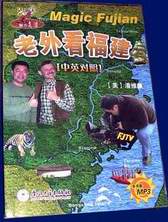![]() Click
to
Access
Click
to
Access
OUTSIDE China
![]() Click
to Access
Click
to Access
INSIDE
China ![]()
TRAVEL LINKS
![]() Xiamen
Xiamen
![]() Gulangyu
Gulangyu
![]() Jimei
Jimei
![]() Tong'an
Tong'an
![]() Jinmen
Jinmen
![]() Zhangzhou
Zhangzhou
![]() Quanzhou
Quanzhou
![]() Wuyi
Wuyi
![]() #1Fujian
Sites!
#1Fujian
Sites!
![]() Fujian
Foto Album
Fujian
Foto Album
![]() Books
on Fujian
Books
on Fujian
![]() Readers'Letters
Readers'Letters
![]() Ningde
Ningde
![]() Zhouning
Zhouning
![]() Longyan
Longyan
![]() Sanming
Sanming
![]() Putian
Putian
![]() Bridges
Bridges
![]() Travel
Info,
Travel
Info,
![]() Hakka
Roundhouses
Hakka
Roundhouses
![]() Travel
Agents
Travel
Agents
MISC. LINKS
![]() Amoy
People!
Amoy
People! ![]()
![]() Darwin
Driving
Darwin
Driving ![]()
![]() Amoy
Tigers
Amoy
Tigers
![]() Chinese
Inventions
Chinese
Inventions
![]() Tibet
in 80 Days!
Tibet
in 80 Days!![]()
![]() Dethroned!
Dethroned!
![]()
![]() Misc.Writings
Misc.Writings
![]() Latest
News
Latest
News
![]() Lord
of Opium
Lord
of Opium
![]() Back
to Main Page
Back
to Main Page
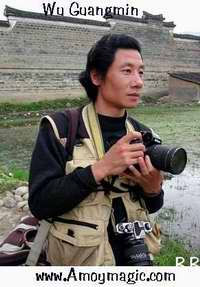
![]() Order
Books
Order
Books![]() Xiamenguide
Forum
Xiamenguide
Forum 

| King
Cobras Square Bamboo! |
Wheel- barrow Wisdom! |
Tao of Tea! | Wuyi Nature Preservation Area | Xiamei Village -- Poker Faces and Blacksmiths |
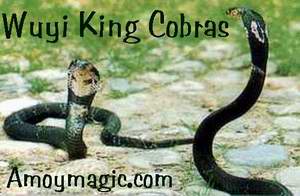 bras
were facing off in the clearing, hoods flared, fangs bared, tongues darting.
Slowly, he pointed his camera at them. “Flash!” Both
serpents turned towards Wu Guangmin. “I couldn’t outrun them,”
he said, “So I took another photo. The flash scared them. They fled
one way and I fled the other!”
bras
were facing off in the clearing, hoods flared, fangs bared, tongues darting.
Slowly, he pointed his camera at them. “Flash!” Both
serpents turned towards Wu Guangmin. “I couldn’t outrun them,”
he said, “So I took another photo. The flash scared them. They fled
one way and I fled the other!”
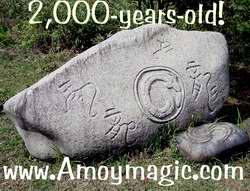 If
Min is the Snake Kingdom of China, Wuyi claims to be the “Snake
Kingdom of the World.” As this 2,000-year-old stone shows,
ancient Min worshipped snakes. And some temples are dedicated to serpent
worship even today.
If
Min is the Snake Kingdom of China, Wuyi claims to be the “Snake
Kingdom of the World.” As this 2,000-year-old stone shows,
ancient Min worshipped snakes. And some temples are dedicated to serpent
worship even today.
In spite of the king cobras, bamboo vipers, and 33-foot
pythons,  Wu
Guangming spends evenings and weekends traipsing about Wuyi Mountain.
Since the late 1700s, European, American and Japanese naturalists have
delighted in its biological diversity, which probably rivals Eden itself.
Fully 92% of Wuyi is forested, and at last count (though I wonder who
on earth counted?), Wuyi boasted 2,466 higher plant species, 840 lower
plant species, 475 vertebrate species, 100 species of mammals, 300 species
of birds, and 31 insect orders with 4,557 species (half of which we had
in our Xiamen University apartment before we screened in the windows).
Wu
Guangming spends evenings and weekends traipsing about Wuyi Mountain.
Since the late 1700s, European, American and Japanese naturalists have
delighted in its biological diversity, which probably rivals Eden itself.
Fully 92% of Wuyi is forested, and at last count (though I wonder who
on earth counted?), Wuyi boasted 2,466 higher plant species, 840 lower
plant species, 475 vertebrate species, 100 species of mammals, 300 species
of birds, and 31 insect orders with 4,557 species (half of which we had
in our Xiamen University apartment before we screened in the windows).
Back to top
Square
Bamboo Bamboo lovers delight in Wuyi’s
80+ bamboo groves, which have 1/3 of the Chinese species of bamboo—including
the exotic, black-skinned square bamboo (Fangzhu). Square bamboo was immortalized
by the ancient poet Guo Mou Ruo in a poem that you can find proudly printed
on “Wuyishan Cigarette” packs. And as a Wuyi native said,
“Square bamboo is great to eat!” (Makes a good square meal,
I bet!)
(By the way--you can also find square bamboo in Northeast Fujian's Taimu
Mountain, in Ningde).Back to top
Wu Guangmin is bent on capturing old China
on film before it vanishes. He said, “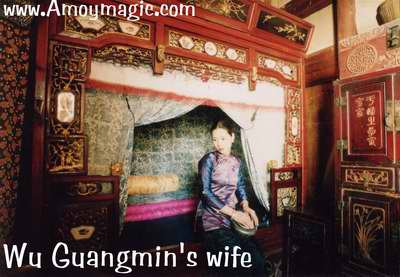 In
another decade you won’t see farmers with plow and oxen, or 3-wheeled
homemade tractors, or grannies with bound feet. And the beautiful architecture
is vanishing—hauled away by antique dealers from Shanghai and Xiamen.
In a few decades all we’ll have is photos.”
In
another decade you won’t see farmers with plow and oxen, or 3-wheeled
homemade tractors, or grannies with bound feet. And the beautiful architecture
is vanishing—hauled away by antique dealers from Shanghai and Xiamen.
In a few decades all we’ll have is photos.”
Armed with black and white film for architecture and color for people
and scenery, Wu Guangmin averages ten rolls of film per day, from which
he may get 3 or 4 acceptable photos. Endless photography is accompanied
by endless questions. “Why did the artists use a dragon theme here,
a phoenix there, a Chinese unicorn between them?” He has published
an entire book on nothing but ancient architecture, with shots of everything
from carved window frames and stone lintels to bed posts. 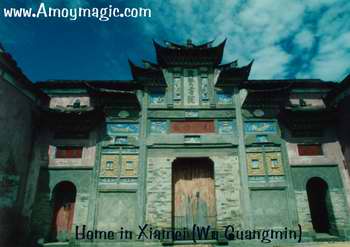
A friend in his hometown of Jian’ou hooked Guangmin on photography
in 1993. He moved to Nanping’s MinBei Daily in 1996, and since moving
to the Wuyi Shan Daily in ‘98, Guangmin has photographed premiers,
presidents, and queens, but his heart is still in culture, tradition—and
nature.
Back to top
Wuyi Welcomes
UNESCO The 60 sq. km. Wuyi National
Scenic Spot, 15 km south of Wuyi City, is best when spring rains create
countless waterfalls coursing through the rich semi-tropical foliage.
And if you book in advance you need never fear getting rained out, because
Wuyi officials have guanxi with the man upstairs. One man solemnly informed
me, “It always pours the few days before official functions, but
never fails to clear up the day of the event.” ....
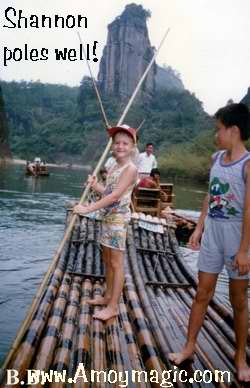 Nine
Bend Stream (Jiuqu Xi) The two-hour rafting excursion
isn’t cheap—80 Yuan a person—but it’s the best
part of Wuyi (besides the climb up Tianyou—Heavenly Tour—Peak).
And you’re actually paying for two rafts strapped together, two
pole-men, the cost of hauling the raft back upstream by truck, and two
hours of nonstop commentary and poetry by men gaily decked out in traditional
blue Chinese jackets and nontraditional bright green plastic boots.
Nine
Bend Stream (Jiuqu Xi) The two-hour rafting excursion
isn’t cheap—80 Yuan a person—but it’s the best
part of Wuyi (besides the climb up Tianyou—Heavenly Tour—Peak).
And you’re actually paying for two rafts strapped together, two
pole-men, the cost of hauling the raft back upstream by truck, and two
hours of nonstop commentary and poetry by men gaily decked out in traditional
blue Chinese jackets and nontraditional bright green plastic boots.
Back to top
Great King Peak
(Da Wang Feng) is at the mouth of the Nine Bend Stream. Given a little
imagination, or a couple of swigs of Chinese rice whisky, it resembles an ancient Chinese official’s hat. On the east
side you can see the Immortal Transformation Cave (Shengzhen Dong). The
great philosopher Zhuxi claimed that King Wuyi once lived in this cave,
but it’s just a hole in the wall.
whisky, it resembles an ancient Chinese official’s hat. On the east
side you can see the Immortal Transformation Cave (Shengzhen Dong). The
great philosopher Zhuxi claimed that King Wuyi once lived in this cave,
but it’s just a hole in the wall.
Jade
Maiden Peak Our poetical pole-man
waxed most lyrical about Wuyi’s most celebrated landmark, Jade Maiden
Peak (Yunu Feng). “She resembles a maiden standing gracefully. The
bare rock is smooth as skin. The grass and shrubbery on top are her hair.
If you gaze at her reflection in the pool below, you’ll see a beautiful,
traditional maid, deep in thought, dreaming of a bright future.”
He’d better lay off the rice whisky! I didn’t think her face
or figure was anything to swoon over, and her hair was a mess. She was
nice for a rock, but I’d never marry her.
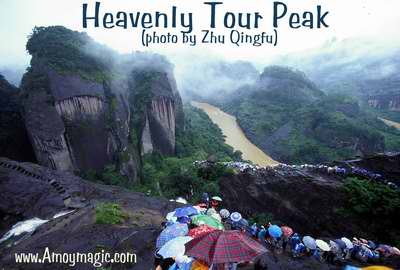 Heavenly
Tour Peak (Tianyou Feng) Wuyi’s best view,
by far, is from Heavenly Tour Peak, which can be seen from the 3rd, 5th,
and 6th bends in the Nine Bend Stream. The path begins at the Tea Plantation
Cave (Chadong) and winds past the Clothes Drying Rock (Shai Bu Yan). Bird’s
Eye Lookout (Yilan Tai) offers a spectacular view of islands of mountains
in a sea of clouds (which Chinese call "The Ends of the Earth")
Heavenly
Tour Peak (Tianyou Feng) Wuyi’s best view,
by far, is from Heavenly Tour Peak, which can be seen from the 3rd, 5th,
and 6th bends in the Nine Bend Stream. The path begins at the Tea Plantation
Cave (Chadong) and winds past the Clothes Drying Rock (Shai Bu Yan). Bird’s
Eye Lookout (Yilan Tai) offers a spectacular view of islands of mountains
in a sea of clouds (which Chinese call "The Ends of the Earth")
Back to top
Min Yue Kingdom Museum
(Chengcun Hancheng Yizhi)
About 35 km south of Wuyi City, south of the 101 highway’s 341 km
marker and the railroad track, lies the 2,000-year-old ruins of the  Minyue
King’s palace.
Minyue
King’s palace.
The 10,000 sq. m palace foundation rises like a lopped off Mayan temple.
It once boasted south-facing palatial buildings, east and west gates,
side gates, east and west wing rooms, and a 10m x 5m bathing pool.
Minyue Well
My companions used the 2,000-year-old well to refill their water bottles.
“The water is still pure, Professor Pan, and cures many illnesses!”
But I wondered how pure it could be with a constant stream of tourists.
Only minutes ago an unfortunate fellow had dropped his eyeglasses down
the well, and who knows what had preceded it.
Today, nothing remains of the ancient Min splendor but the great foundation,
a few reconstructed walls, outlines of the rooms’ foundations, and
a large expanse of grass. Here and there, glass-covered square casements
on the ground allow tourists to see the original baked gray tiles, with
their geometrical designs.
The MinYue Museum, a castle-looking
affair a few hundred meters south of the ruins, has a large mural of peasants
adoring the skirted MinYue King, a statue of the mighty man, and some
excavated pottery to shed light on how the kingdom went to pot.
It’s worth a stop, but even more fascinating is
the marvelously preserved Ming Dynasty Village just a couple of kilometers
further up the road, past the ruins...
Tea House & Roots Our
first stop was the teahouse opened February, 2001, in a house built in
1620. The proud young proprietor, Mr. Zhao Shan Zhong, showed us his Ancestral
Records book, and boasted that he was the 37th generation of the line
in the middle. He asked about my own roots and was surprised to learn
that I had no idea who my great, great grandfather was...
The ancient cobble stone path was awkward, but it beat mud. It did have
a narrow six-inch smooth stone path down the middle, monopolized by bicycles
and the ingenious one-wheel wheelbarrows that epitomize Chinese ingenuity
and practicality.
Wheelbarrow
Wisdom It is said General Liang
invented 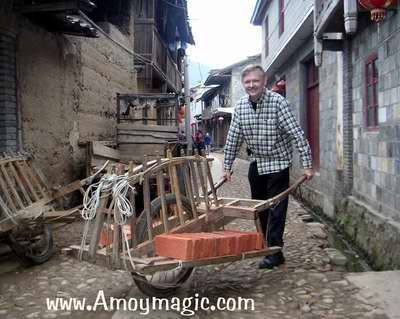 wheelbarrows
about 1800 years ago. With the center of gravity over the one immense
wheel, the user has only to balance and steer the “wooden ox”—unlike
western wheelbarrows, in which the user must heft much of the load.
wheelbarrows
about 1800 years ago. With the center of gravity over the one immense
wheel, the user has only to balance and steer the “wooden ox”—unlike
western wheelbarrows, in which the user must heft much of the load.
The imminently practical Chinese wheelbarrow transported
everything from produce to people, and with only one wheel, the wooden
ox easily navigated the rice paddies’ narrow dikes that were South
China’s only roads well into the 20th century. Back
to top
Nitpicking Tea Pickers A
couple dozen people in an old courtyard
were sorting tea leaves. I vowed I’d never again take tea for granted.
It is an amazingly tedious job, sorting and selecting the tiniest, most
perfect leaves, and tossing the stems. It’s hard to imagine tea
can be so cheap, given the labor behind one pot of the stuff.
While I shot photos, two of the ladies began yelling at one another in
the local dialect. Finally, the taller lady dragged the smaller one outside
the house, to box her ears I 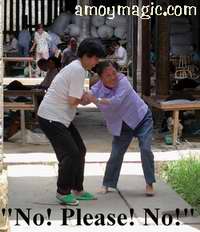 suspected…
suspected…
After more fierce arguing, she ran inside and grabbed her victim’s plastic flip flops and hand fan, wrestled with her some more, and finally grabbed her by the back of her shirt and led her, triumphantly, down the street. To the judge? To jail? Wu Guangmin laughed as he explained. “She was simply inviting her next-door neighbor to lunch! Chinese keqi (ceremonial politeness) of course requires her to refuse at least 2 or 3 times—but even I have never seen it carried this far!”
Gucheng
Ferry Behind Gucheng was an old reddish temple
to Mazu, the sea goddess. The granny caretaker invited me in and said,
“Some foreigner left this hat here. Is it yours?” And here
I thought I was blazing new trails....
“Twenty and Seven tally with the doctrine ‘Three times
Nine.’ One will be calm and feel moist in the throat and sweet between
teeth. It’s a great pleasure to travel and drink the famous tea
in the Wuyi Mount.”
...............................................From
Wuyi brochure
The
Tao of Tea When the Dutch Trading
Company first shipped tea from Macao to Europe, back in 1607, they called
the blissful brew “Wuyi,” pronounced just like the noise my
West Virginian uncles make after swigging home brewed white lightning:
Wooyee! Tea doesn’t pack the same punch as that Appalachian ambrosia,
but it does have enough caffeine that ancient Chinese medics prescribed
it for everything from impotence to palsy.
Chinese, especially Fujianese, take tea seriously. A Taiwanese friend
gave me a small canister of tea that set him back $200 US. “Don’t’
waste it on me!” I protested. “I can’t tell Coke from
Pepsi, much less $200-a-pound tea from the local fifty-cent variety.”
“You must learn,” he argued, “To savor the bouquet like
a fine wine, and allow a few drops to tantalize the tongue, and enjoy
the bite and the sweetness that follow the swallow.” So he prepared
the elegant Minnan Tea Ceremony, which is the father of the elaborate
Japanese version, but simpler. While Chinese seem to “stand on ceremony”
regarding all else in life, they never allow ritual to spoil their enjoyment
of fine food or tea (or women, judging from their 1.3 billion population).
My friend proffered, with two hands of course, the tiny Minnan teacup,
which is little more than a clay thimble, and frustratingly inefficient
for someone used to Super Big Gulps and two-handed German steins. I sniffed
it dutifully, then downed the cup and smacked my lips. “Good stuff,”
I said. My Taiwanese friend sighed in resignation, and probably regretted
the waste of good tea on his barbarian friend. But it was not wasted.
I served it later to my Chinese guests, who reveled in it.
Back to top
 The
Tea is Within You! Near the large stone statue of Maitreya
(Milofu) is the Heavenly Heart Eternal Happiness Meditation Temple (Tianxin
Yongle Chansi), Wuyi’s largest Buddhist complex. It was built about
879 A.D. on one of Chinese Buddhism’s eight holiest mountains. The
temple’s Abbot expounded for me the spiritual ramifications of tea
tasting.
The
Tea is Within You! Near the large stone statue of Maitreya
(Milofu) is the Heavenly Heart Eternal Happiness Meditation Temple (Tianxin
Yongle Chansi), Wuyi’s largest Buddhist complex. It was built about
879 A.D. on one of Chinese Buddhism’s eight holiest mountains. The
temple’s Abbot expounded for me the spiritual ramifications of tea
tasting.
His overview of Buddhism was obviously tailored to his barbarian audience.
He said Guanyin has a master’s degree and Buddha a Ph.D., but that
no one has yet reached the post doctorate pinnacle of enlightenment.
As the Abbott brewed his beverage he explained, “Some people can’t
tell good tea from bad.” Before I couldvolunteer myself for that
category he added, “That’s because those people have nothing
spiritual about them. A taste for tea cannot be taught or learned. It
is in one’s heart.”
I wonder how the Abbott would fare spiritually at Starbucks? ...
Back to top
One Size Fits All 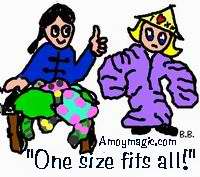 A
dozen vendors hawking carved stones, glass-cum-crystal necklaces, and
miniature bamboo rafts and palm fiber capes besieged us as. We haggled
over a mini raft and rain cape, and the granny exclaimed, “You’re
great at bargaining! Ok, I’m losing money on this sale—but
for the foreign friend…” They turned out to be half the price
in town.
A
dozen vendors hawking carved stones, glass-cum-crystal necklaces, and
miniature bamboo rafts and palm fiber capes besieged us as. We haggled
over a mini raft and rain cape, and the granny exclaimed, “You’re
great at bargaining! Ok, I’m losing money on this sale—but
for the foreign friend…” They turned out to be half the price
in town.
No one dickers like the Chinese. Years ago in Longyan, Sue told a street
vendor that a sweater was too small. The lady replied, "Bu yao
jin! (No problem!) They stretch when you wear them!”
“I don’t know…” Sue said. She tried another but
it was too large.
“Bu yao jin!” the granny said. “They shrink
when you wash them!”
Tea’s
Holy of Holies After the gatekeeper ripped our
tickets in half and handed us the stubs, we made our way up a narrow stone
path winding beside a cold creek that meandered between narrow blackened
cliffs covered with moss, ferns and wild azaleas. Little striped fish,
like clown loaches, frolicked in the icy creek.
Wuyi’s climate, the rich nutrients in the soil, the narrowness and
direction of the valley (strong sun at noon, weak the rest of the day),
and the high humidity from the continual runoff have created the perfect
environment for growing Fujian’s finest tea.
If you aren't into hiking through surrealistic scenery, you can pretend
to be a Mandarin and be borne by quaintly clad Chinese on a colorful litter.
They don’t provide cymbals and shouting attendants cracking whips
to clear the path ahead, though I suppose you could pay extra for it....
Big Red Robe
We crossed the creek on small stones, passed a small Chinese pavilion
(for small Chinese tourists?), and entered an ancient gate that warned,
“No Smoking!” because the three bushes within are the planet’s
sole source of Big Red Robe tea, and irreplaceable.
Many legends explain the origin of the name “Red Robe.” One
claims that monkeys helped the kind monks of Tianxin temple to pick the
best leaves from the highest branches. The Emperor owned the monkeys,
so they wore red robes, and clamoring through the tea bushes they resembled
bright red flowers. Another legend claims an imperial official sent to
supervise tea picking hung his red robe in the tree and joined in the
picking himself.
The three Big Red Robe bushes originally grew wild on top of the mountain,
but centuries ago slid halfway down and have clung there since. All other
Red Robe bushes descend from these three, and are called Little Red Robe.
Big Red Robe bushes are never watered, so the flavor varies year to year,
depending upon the mineral content and the weather. The flavor is flowery
some years and milky others. Little Red Robe tea, I was told, almost always
has a somewhat milky flavor—though the flavor improves as the bushes
age (and the higher the elevation, the better the flavor).
Since less than a pound of Big Red Robe is grown annually, it is usually
reserved for Big Red Bigwigs, at the 2nd Canton Tea Fair in 2002, a mere
20 grams of this most famous of Oolong teas was auctione-for 180,000 Yuan!
That’s more than we spent on Toy Ota! (That’s a bit over 400,000
USD a pound.) I’ll probably never taste Big Red Robe, and I wouldn’t
appreciate it if I did, but Wu Guangmin did give me some Shuixian Hong
Cha (Narcissus Black Tea). “It’s very rare,” he said.
“It is grown in the nature preserve, and only 20 pounds were picked
this year. It was roasted with wood, not coal, with a layer of stone over
that, so it preserves the taste of stone and wood.” That was the
second time someone had raved about the flavor of wood and stone. I wonder
if Chinese ever make stone soup?
Later, Wu Guangmin brewed up a pot of Narcissus Black Tea, and I sniffed
the bouquet, and rolled it around my tongue, and sipped slowly from the
Minnan tea thimble. It still tasted the same to me as the 50 cent stuff--but
I’ll never tell that to the Buddhist Abbott.
Back to top
 Water
Curtain Falls (Shuilian Dong) Our guide gave Shannon and
Matthew bottles of mineral water and said, “Refill them from any
spring along the road. They’re all pure!” Then she asked,
“Anyone need to sing a song?” Karaoke in the mountains?! It
turned out this was a local euphemism for going to the bathroom—so
I sang several stanzas.
Water
Curtain Falls (Shuilian Dong) Our guide gave Shannon and
Matthew bottles of mineral water and said, “Refill them from any
spring along the road. They’re all pure!” Then she asked,
“Anyone need to sing a song?” Karaoke in the mountains?! It
turned out this was a local euphemism for going to the bathroom—so
I sang several stanzas.
An elderly couple at the Water Curtain Falls’ base charged two Yuan
for photos with their pigeons. The granny placed corn in the boys’
hands, blew her whistle, and the birds shot into the air, flying about
madly like the birthday party scene from Hitchcock’s “The
Birds.” It took several whistles to get a photo with a bird in each
hand, and I was bushed, but a bird in each hand is better than twenty
in the bush.
The so-called Water Curtain looked more like runoff from a gigantic leaky
faucet than a curtain, but the sheer granite cliff, the pond, and the
tropical plants gave the frail falls an exotic setting. 
The Hall of Three Sages,
who in their day dispensed thymely advice, is halfway up the trail to
the right of the pond, was built in 1147 as a memorial hall for Master
Pingshan, and renovated in 1923. Folk from all over Fujian flock here
to pay homage to Liuzihui (1101-1147), Liufu (?-1181, student of Liuzihui),
and Zhuxi, who founded Neo-Confucianism in his “Wuyi Institute.”
Wuyi
Nature Preservation Area The following morning
we headed for the Wuyi Nature Museum on lofty Huanggan Mountain. A bus
makes the trip daily from Wuyi’s Short Distance Bus Station (Duantu
Chiche Zhan), and several buses a day go to the lower areas. Laowai need
passports to enter, as this is a UNESCO preservation area.
The road was so bumpy I had to clutch the seat in front with both hands.
I finally said, “I’m moving to the front of the bus.”
“Good idea,” the driver said. “The bad road’s
coming up.”
The museum’s vast display of stuffed animals, birds, reptiles, and
mounted insects more than made up for my disappointment. Tourists remarked,
“Oh yes, this one is good to eat. That one is too. But that one
is so expensive—$2000 yuan each!”
Back to top
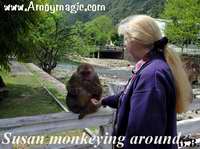 Monkey
Business The monkeys heard our bus approach and raced
down the mountainsides to the parking lot to snatch tourists’ peanuts.
One man saved his entire breakfast for the simians: fried eggs, tofu,
fruit, and pickled vegetables. But they wouldn’t touch a bit of
it. Maybe he should have offered them chopsticks as well...
Monkey
Business The monkeys heard our bus approach and raced
down the mountainsides to the parking lot to snatch tourists’ peanuts.
One man saved his entire breakfast for the simians: fried eggs, tofu,
fruit, and pickled vegetables. But they wouldn’t touch a bit of
it. Maybe he should have offered them chopsticks as well...
Worker Exploitation
A few years back it was reported that a tiny 7-ounce mouse-sized Chinese
monkey had been rediscovered in Wuyi Mountains. A 12th century Chinese
scholar supposedly trained these miniature monkeys to prepare ink, pass
brushes, and turn pages. But it was sheer exploitation of labor, because
the monkeys slept in tiny pots and worked for peanuts.
Animal Rescue Restaurant The
Animal Rescue Center, just up the road from the Museum of Natural History
and across a small wooden bridge, housed a peacock and a few other small
creatures, including a blind bear and a bear missing a paw. Maybe the
paw went to the restaurant across the lawn, where we had a lunch of wild
veggies and creatures. So many tourists exclaimed, “Wah! Those are
good to eat!” that I wondered if the Rescue Center wasn’t
a joint venture with the restaurant, but the restaurant manager assured
me, not without a touch of regret, I think, “No protected species
on our menu!” 
YulingTing Song Dynasty
Dragon Kiln Just west of Wuyi, two long narrow buildings
snake up facing hillsides like dragons—which in fact they were built
to resemble. Dragon kilns originated in south China about 2,000 years
ago, and this site is all that remains of two of the Song Dynasty’s
longest dragon kilns (2m by 113m). Shards of Song Dynasty porcelain and
pottery molds are so numerous that locals use them to build field walls.
The extinct dragons lie with heads at the base of the hill and tails at
the top. Each kiln had a fire bore, kiln house, and smoke outlet, and
could produce about 80,000 porcelain pieces at a shot. The wares were
fired at 1100? to 1200? for forty hours or so, and cooled for another
24 before they could be taken out to produce the exotic gold-accented
black-glazed porcelain so prized by the Japanese and Koreans.
Potters A
potter demonstrated his craft outside the Ceramic Café, which is
by the pond and the wooden waterwheel. He had two electric potter’s
wheels, but the power was out that day, so he tried his hand at the stone
potter’s wheel, which didn’t even have a foot pedal and had
to be spun by hand.
But every time he’d spin the wheel with one hand, the other hand
would knock his creation out of round, and after scrapping the piece three
times he finally gave up, explaining, “I’m used to the electric
wheel.”
He should have fired it anyway, and sold it to Americans
who think ‘handmade pottery’ necessarily implies misshapen
mugs with big handles and designs painted by a child who has yet to finish
his first coloring book.
Back to top
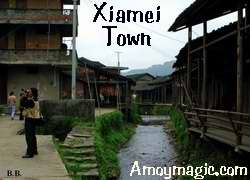 Xiamei
Village Some of Wu Guangmin’s most prized black
and white photos of classic Chinese architecture were taken in the farming
village of Xiamei, 13 km east of Wuyi City on the road to Wufu (which
means “Five Husbands”). But Guangmin was as shocked as I when
a Xiamei farmer at the village gate demanded, “20 Yuan admission—each!”
Xiamei
Village Some of Wu Guangmin’s most prized black
and white photos of classic Chinese architecture were taken in the farming
village of Xiamei, 13 km east of Wuyi City on the road to Wufu (which
means “Five Husbands”). But Guangmin was as shocked as I when
a Xiamei farmer at the village gate demanded, “20 Yuan admission—each!”
Wu Guangming flashed his Press pass but the man said, “I don’t
care. Everyone pays 20 Yuan to enter.”
“I’ve been here many times!” Mr. Wu protested. “My
articles and photos put Xiamei on the map!” And Mr. Wu and his wife
strode past the angry farmer with my sons and I in tow. What a contrast
from the usual, “Come in! Have some tea!” Guangming was embarrassed,
and apologized. “This is rare. People here aren’t like that.”
And he was right. Except for one granny who yelled, “No ticket,
no photos!” the rest of the village treated us like long lost relatives
divvying up the inheritance.
Bony is Beautiful?
One ancient courtyard had a board displaying news articles and photos
that Wu had taken about women with bound feet. “It was a horrible
practice,” a man said.
“True—but we bound women’s entire bodies with corsets,”
I said.
“At least that’s behind us now,” he said.
“True,” I agreed. “Nowadays bony is beautiful and women
voluntarily starve themselves for fashion.”
Poker Faces and Blacksmiths Half a dozen grandpas playing poker were proof positive that Chinese invented not only playing cards but also the poker face. What expressions! Not even the foreigner snapping photos broke their concentration!
Just opposite the poker game were two blacksmiths, husband
and wife, hammering away at red-hot steel. “I do it the same way
as my forefathers before me,” the man said proudly.
 He was bearded and wiry, but strong, but his wife wielded the bigger hammer
of the two (though she wasn’t bearded). They proudly let me photograph
them at work, even suggesting various poses, and stoking up the flames
for better effect. And they didn’t charge me 20 Yuan for it.
He was bearded and wiry, but strong, but his wife wielded the bigger hammer
of the two (though she wasn’t bearded). They proudly let me photograph
them at work, even suggesting various poses, and stoking up the flames
for better effect. And they didn’t charge me 20 Yuan for it.
Chinese worked with iron and steel 2000 years before Columbus discovered
America. By 400 B.C. (1600 years before Europeans) they used cast iron
to make everything from tools and weapons to pots, pans, and utensils
(and even a solid cast-iron pagoda, in Luoning, Shandong Province!). By
the second century B.C. they’d figured out how to make steel from
cast iron....
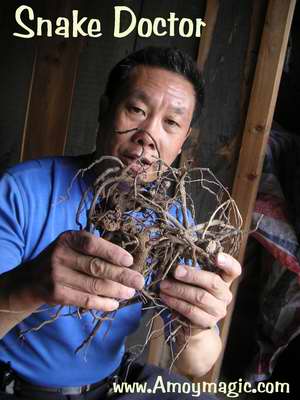
Snake Doctor It’s
no surprise that the Snake Kingdom of Wuyi has a Snake Garden (Dazhu Gang
Sheyuan) boasting over 10,000 snakes within its 6,000 sq. m domain (entrance
fee cheerfully refunded if you’re fatally bitten). It’s also
no surprise that Snake Doctors like Xiamei Village’s Master Wang
are in high demand.
Master Wang’s uncle taught him the ancient Chinese herbal cures
from a dusty old tome, and since Wang is illiterate, he memorized them
by rote. There’s no telling what kind of pharmaceutical treasures
are in the man’s head—though he admits to some close calls
at times. “Sometimes, I have to care for patients 8 or 10 days,
especially if they’ve been bitten by a five stepper or a bamboo
viper. If they’d have gone to the hospital, they’d have probably
died, or at least lost an arm or a leg.”
“People lose arms and legs all the time in American hospitals,”
I said.
“Really?” he asked, in astonishment.
“Really,” I said. “Hospitals cost an arm and a leg.”
Snake Oil For
Chinese, snakes are as much boon as bane, because virtually every part
of the snake is considered medicinal, and capable of miraculous cures.
In the Tourist District’s Bite and Sup Street, you can find shops
selling an unimaginable variety of snakes, some pickled in alcohol in
jars of various sizes, and others coiled and dried.
My first intro to snake medicine was in Taiwan, when aborigines milked
a cobra’s venom into a glass of rice whisky and gave it to me to
drink. “Makes you potent!” they said.
“No thanks. Don’t need it,” I said.
“Ohhhh!” They said. But they pressed the issue, and so I drank
it, knowing that it wouldn’t harm me unless I had cuts or ulcers
in my esophagus or stomach. I probably developed ulcers waiting to find
out.
Snake flesh and internal organs all have their uses. The gall bladder
alone can sell for as much as $1,000 US, depending upon the type and size
of the snake. Gall bladders alleviate arthritis pain, and are usually
taken with alcohol, which speeds the snake essence through the body...
Snake penises, soaked in herbs and liquor for 2 to 3 years, are sold for
a small fortune as a Chinese version of Viagra, though more sophisticated
snake experts claim the benefit comes not from the penises but from the
herbs and liquor they’re soaked in.
Back to top
Snake Oil Magical Wine It’s
a wonder there are any snakes left in China, given that this has been
going on for a few thousand (plus 14) years. Back in the Tang Dynasty,
Liu Zong Yuan wrote about the Yi snake ("strange snake"), which
was black, with a white stripe:
“Yishe can recuperate palsy, sprain and swelling, eliminate dead
muscles and kill harmful germs. So imperial physicians began to collect
Yishe twice a year following imperial edicts. People who can catch Yishe
are in great demand, and since they can hand in snakes in lieu of taxes,
many people of Yong Zhou risk their lives to do it.”
Today, a Hunan firm produces “Yishe Magical Wine,” which,
among other things, cures......
Wuyi City
Sprawling Wuyi City is, on the surface at least, not much different from
thousands of other modern Chinese cities—though there is a marvelous
little street along the riverfront, lined with ramshackle old wooden buildings,
and the 100-meter TuQing wooden covered bridge (circa 1187).
But most of Wuyi’s action is in the newly developed Wuyi National
Tourism and Holiday Area, 11 km south of the city proper (or improper,
late at night). On “Bite And Sup Street,” you can shop and
eat to your heart’s content.
 Bite
& Sup Street’s sidewalk restaurants
serve up every dish you can imagine and a few you’d rather not.
Breakfast features tiny pickled onions, sad dried minnows, rice congee,
zongzis (triangular bamboo-wrapped sticky rice with veggies or meat),
deep-fried spring rolls, miniature Chinese steamed buns and dumplings—and
of course the old standby of hot soy milk and youtiao (deep fried dough
sticks).
Bite
& Sup Street’s sidewalk restaurants
serve up every dish you can imagine and a few you’d rather not.
Breakfast features tiny pickled onions, sad dried minnows, rice congee,
zongzis (triangular bamboo-wrapped sticky rice with veggies or meat),
deep-fried spring rolls, miniature Chinese steamed buns and dumplings—and
of course the old standby of hot soy milk and youtiao (deep fried dough
sticks).
Bite and Sup Street is best in the cool of the evening when the brightly
illuminated stalls showcase colorful displays of vegetables, fruits, and
assorted carcasses—some of which are still alive and kicking in
cages and aquariums.
Rabbit, pheasant, miniature mountain deer, king cobra—Bite and Sup
Street is Wuyi’s best zoo. My favorites included the wild mountain
veggies, mushrooms and fungi, and the sweet ‘n sour potatoes, though
the tofu and snails weren’t bad either. One exquisite treat you
can’t miss: Tempura Tea! These are delicate little
Rougui Tea leaves, battered and deep fried. Only in Wuyi can you have
your tea and eat it too!
Wuyi Handicrafts—the Best
Buys in Fujian The shops around Bite and
Sup Street offer the best bargains in Fujian on teas, mushrooms, funguses,
and Chinese handicrafts. The locally made wood, bamboo, and snakeskin
products go for 3 times the price even in neighboring Sanming.
Our favorites include the wooden Chinese puzzle boxes
with their secret compartments, and the miniature reproductions of Fujian
farmers’ hand woven palm fiber capes and hats (which take a couple
of days to make and are rapidly giving way to lighter but stifling plastic
raincoats).
Antique Alley An
abundance of extinguished forebears makes for a bustling antique business
in Wuyi. Dealers from all over China come here to buy ancient pottery
and carved wooden lattices, which they resell at several times the price
in Fuzhou, Xiamen, and Shanghai.
Wu Guangmin introduced me to Mr. Zhou Gao Ying, one of the few art dealers
he trusted. Mr. Zhou had sold antiques out of his home for ten years,
parlaying his profits until he was able to open Gu Yue Xuan. He showed
me some marvelous Tang and Song Dynasty wares, and when I asked how to
tell the real from the fakes, he admitted, “It’s hard to tell.
But these came from local graves, so I know.”
A grave undertaking, to be sure—but the only reliable way of insuring
you’re getting the Real McCoy and not a clever copy. Even then,
caveat emptor. Back in 1932, a Fuzhou Laowai, Malcolm Farley, warned the
wannabe antique collector:
“Since about five years [1927] ago the demands of the museums of
the West and Japan ever increasing for these wares and the supply diminishing
somewhat, certain potters in the north, notably in Honan set out to meet
this demand artificially and have succeeded so well in doing so that now
when even a collector of some acumen buys one of these Han and Tang pieces
he is not sure of whether he is getting one a thousand or two thousand
years old or one made within the past five years or two months. I mean
this literally. The reproductions are so perfect, so well done as to deceive
the expert often and it is hardly to be doubted that almost any museum
may possess some fakes along side of genuine specimens in their cases.”
Back to top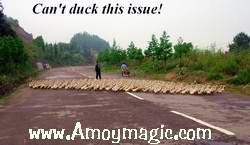
Wuyi Mountain Villa Wuyishan
City has 18 travel agencies, over 130 hotels, and 10,000 beds, so plenty
of room and board. Literally, because the beds are generally about as
soft as a board. My favorite hangout is where the Queen of the Netherlands
stayed: the Wuyishan Villa (Wuyishan ShanZhuang), which has been included
in a book on the world’s best architecture. Great rooms, excellent
food, and some of the best service we’ve seen in China. Try it!
But like the Queen of the Netherlands, you’ll have to go Dutch.
Homeward Bound Our Wuyi
sojourn ended, we bade many new friends farewell and piled into Toy Ota
for the trip home.
Just out of town, and just beyond the “Toll—Run Slowly!”
sign, a flock of ducks blocked the road.
“How many ducks you got?” I called out.
“Oh, about five hundred” the duck herder said proudly, as
he swished his pole, slowly, to clear a way for me to pass.
“Bu yao jin!” I yelled back. “No worries, Mate!”
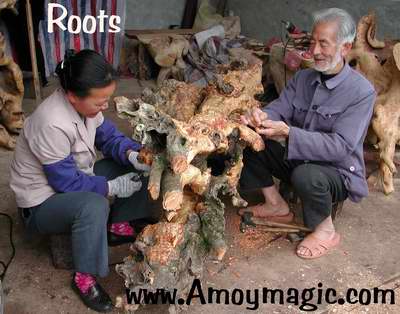 Roots
About the 297.7 kilometer marker we came to a village that specializes
in root sculptures....
Roots
About the 297.7 kilometer marker we came to a village that specializes
in root sculptures....
And on to Sanming.....
TRAVEL
LINKS  Favorite
Fujian Sites
Favorite
Fujian Sites  Fujian
Foto Album
Fujian
Foto Album  Xiamen
Xiamen
 Gulangyu
Gulangyu
 Fujian
Guides
Fujian
Guides  Quanzhou
Quanzhou
 Zhangzhou
Zhangzhou
 Longyan
Longyan
 Wuyi
Mtn
Wuyi
Mtn  Ningde
Ningde
 Putian
Putian
 Sanming
Sanming
 Zhouning
Zhouning
 Taimu
Mtn.
Taimu
Mtn.  Roundhouses
Roundhouses
 Bridges
Bridges
 Jiangxi
Jiangxi
 Guilin
Guilin
 Order
Books
Order
Books
 Readers'
Letters
Readers'
Letters
Last Updated: May 2007
![]()
DAILY
LINKS
![]() FAQs
Questions?
FAQs
Questions?
![]() Real
Estate
Real
Estate
![]() Shopping
Shopping
![]() Maps
Maps
![]() Bookstores
Bookstores
![]() Trains
Trains
![]() Busses
Busses
![]() Car
Rental
Car
Rental
![]() Hotels
Hotels
![]() News
(CT)
News
(CT)
![]() Medical
& Dental
Medical
& Dental
![]() YMCA
Volunteer!
YMCA
Volunteer! ![]()
![]() XICF
Fellowship
XICF
Fellowship
![]() Churches
Churches
![]()
![]()
![]() Temples
Temples![]()
![]() Mosque
Mosque
![]() Expat
Groups
Expat
Groups
![]() Maids
Maids
![]() Phone
#s
Phone
#s
EDUCATION
![]() Xiamen
University
Xiamen
University
![]() XIS(Int'l
School)
XIS(Int'l
School)
![]() Study
Mandarin
Study
Mandarin
![]() CSP(China
Studies)
CSP(China
Studies)
![]() Library
Library
![]() Museums
Museums
![]() History
History
DINING ![]() Tea
Houses
Tea
Houses
![]() Restaurants
Restaurants
![]() Asian
Asian
![]() Veggie
Veggie
![]() Junk
Food
Junk
Food
![]() Chinese
Chinese
![]() Italian
Italian
![]() International
International![]()
![]() Visas
4 aliens
Visas
4 aliens
RECREATION
![]() Massage!
Massage!
![]() Beaches
Beaches
![]() Fly
Kites
Fly
Kites
![]() Sports
Sports
![]() Boardwalk
Boardwalk
![]() Parks
Parks
![]() Pets
Pets
![]() Birdwatching
Birdwatching
![]() Kung
Fu
Kung
Fu ![]() Hiking
Hiking
![]() Music
Events
Music
Events
![]() Cinema
Cinema
![]() Festival&Culture
Festival&Culture
![]() Humor&
Humor&![]() Fun
Fotos
Fun
Fotos![]()
BUSINESS
![]() Doing
Business
Doing
Business
![]() Jobs!(teach/work)
Jobs!(teach/work)
![]() Hire
Workers
Hire
Workers
![]() Foreign
Companies
Foreign
Companies
![]() CIFIT
(Trade Fair)
CIFIT
(Trade Fair)
![]() MTS(Translation)
MTS(Translation)
![]()
Back to Top





